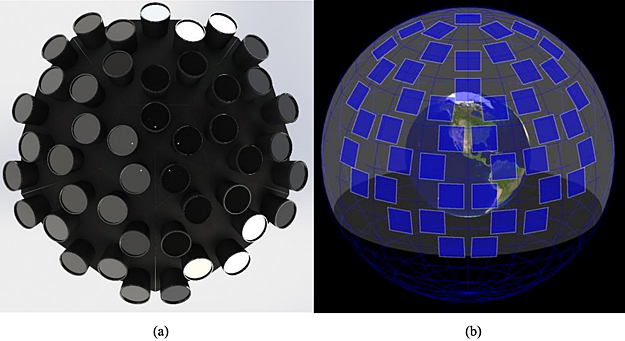Panoramic SETI: Overall Mechanical System Design

PANOSETI (Pulsed All-Sky Near-infrared Optical Search for Extra Terrestrial Intelligence) is a dedicated SETI (Search for Extraterrestrial Intelligence) observatory that is being designed to observe 4,441 sq. deg. to search for nano- to milli-second transient events.
The experiment will have a dual observatory system that has a total of 90 identical optical 0.48 m telescopes that each have a 99 square degree field of view. The two observatory sites will be separated by 1 km distance to help eliminate false positives and register a definitive signal. We discuss the overall mechanical design of the telescope modules which includes a Fresnel lens housing, a shutter, three baffles, an 32×32 array of Hamamatsu Multi-Photon Pixel Counting (MPPC) detectors that reside on a linear stage for focusing.
Each telescope module will be housed in a triangle of a 3rd tessellation frequency geodesic dome that has the ability to have directional adjustment to correct for manufacturing tolerances and astrometric alignment to the second observatory site. Each observatory will have an enclosure to protect the experiment, and an observatory room for operations and electronics. We will review the overall design of the geodesic domes and mechanical telescope attachments, as well as the overall cabling and observatory infrastructure layout.
Aaron M. Brown, Michael L Aronson, Shelley A. Wright, Jérôme Maire, Maren Cosens, James H. Wiley, Franklin Antonio, Paul Horowitz, Rick Raffanti, Dan Werthimer, Wei Liu
Comments: 11 pages, 10 figures, SPIE 2020
Subjects: Instrumentation and Methods for Astrophysics (astro-ph.IM)
Cite as: arXiv:2111.12771 [astro-ph.IM] (or arXiv:2111.12771v1 [astro-ph.IM] for this version)
Submission history
From: Aaron Brown
[v1] Wed, 24 Nov 2021 20:05:38 UTC (782 KB)
https://arxiv.org/abs/2111.12771
Astrobiology, SETI








